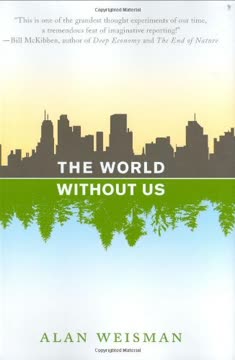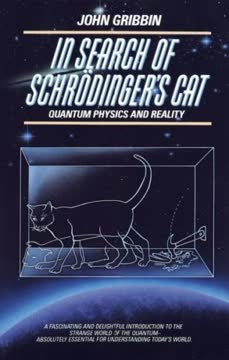Key Takeaways
1. The universe's scale and our place in it evolved through scientific discovery
"To be sure, Galileo did not invent the telescope, though he improved it, and applied it to astronomy."
Ancient misconceptions: Early humans believed in a small, Earth-centered universe. The stars were thought to be fixed on a celestial sphere, and the Earth was considered the center of all creation.
Scientific revolution: The invention and improvement of the telescope by Galileo and others led to groundbreaking discoveries:
- Moons orbiting Jupiter
- Phases of Venus
- Mountains on the Moon
- Countless previously unseen stars
These observations challenged the geocentric model and paved the way for the heliocentric model proposed by Copernicus and refined by Kepler. The realization that Earth was not the center of the universe was a profound shift in human perspective.
Expanding horizons: As observational techniques improved, our understanding of the universe's scale grew exponentially:
- William Herschel discovered Uranus, doubling the known size of the solar system
- Edwin Hubble proved the existence of other galaxies beyond the Milky Way
- Modern cosmology revealed a vast universe billions of light-years across, containing trillions of galaxies
2. Relativity and quantum mechanics revolutionized our understanding of space and time
"Einstein determined that the rate at which time flows and the length of distances gauged across space vary, according to the relative velocities of those measuring them."
Einstein's revolution: Special and general relativity transformed our conception of space and time:
- Space and time are not absolute, but relative to the observer's motion
- Gravity is the curvature of spacetime caused by massive objects
- The speed of light is constant for all observers
These ideas led to mind-bending consequences:
- Time dilation
- Length contraction
- Mass-energy equivalence (E = mc²)
Quantum weirdness: At the subatomic level, classical physics breaks down:
- Particles exhibit wave-like properties
- Heisenberg's uncertainty principle limits our knowledge of a particle's position and momentum
- Quantum entanglement allows for "spooky action at a distance"
These discoveries forced scientists to abandon deterministic views of nature and embrace probability and uncertainty as fundamental aspects of reality.
3. The search for symmetry drives progress in particle physics and cosmology
"Nature seems to take advantage of the simple mathematical representation of the symmetry laws."
Symmetry in physics: Physicists have discovered that symmetries in nature often reveal fundamental truths about the universe:
- Conservation laws (energy, momentum, charge) arise from symmetries in physical laws
- Particle physics classifications (quarks, leptons) are based on symmetry groups
Symmetry breaking: The concept of spontaneous symmetry breaking has been crucial in understanding:
- The origin of particle masses
- The separation of fundamental forces in the early universe
Unification theories: The search for underlying symmetries has led to attempts at unifying fundamental forces:
- Electroweak theory (unifying electromagnetism and the weak nuclear force)
- Grand Unified Theories (GUTs)
- String theory and M-theory
These efforts aim to describe all known particles and forces within a single, elegant mathematical framework, potentially revealing the universe's deepest secrets.
4. The Big Bang theory emerged as the leading model of cosmic origins
"The realization that we live in an expanding universe rests upon three fundamental lines of research."
Evidence for the Big Bang:
- Hubble's law: The observation that distant galaxies are receding faster than nearby ones
- Cosmic Microwave Background Radiation: The afterglow of the early, hot universe
- Primordial element abundances: The observed ratios of light elements match Big Bang predictions
Timeline of the early universe:
- 10⁻⁴³ seconds: Planck epoch (quantum gravity regime)
- 10⁻³⁵ seconds: Inflation begins, rapidly expanding the universe
- 10⁻³² seconds: Fundamental forces separate
- 3 minutes: Nucleosynthesis of light elements
- 380,000 years: Recombination, universe becomes transparent
Challenges and refinements: The Big Bang theory has faced challenges, leading to refinements:
- Inflation theory to explain the universe's flatness and homogeneity
- Dark matter and dark energy to account for observed gravitational effects and accelerating expansion
5. Stars are the crucibles where elements are forged
"The stars are the crucibles in which the lighter atoms which abound in the nebulae are compounded into more complex elements."
Stellar nucleosynthesis: Stars are cosmic factories, fusing lighter elements into heavier ones:
- Hydrogen fusion in main sequence stars
- Helium fusion in red giants
- Carbon, oxygen, and heavier elements in massive stars
Supernova enrichment: The death of massive stars in supernova explosions:
- Creates and disperses heavy elements throughout the galaxy
- Provides the raw materials for planet formation and life
Cosmic recycling: The elements in our bodies and surroundings have a stellar origin:
- First-generation stars formed from primordial hydrogen and helium
- Subsequent generations incorporated heavier elements from previous stellar deaths
- This cycle continues, gradually enriching the universe with complex elements
6. Dark matter and energy challenge our understanding of the universe
"The startling implication is that everything we see and photograph in the sky amounts to only a fraction of the gravitationally interacting matter in our quarter of the universe."
Dark matter evidence:
- Galaxy rotation curves
- Gravitational lensing
- Cosmic microwave background fluctuations
Dark matter candidates:
- Weakly Interacting Massive Particles (WIMPs)
- Axions
- Primordial black holes
Dark energy mystery: Observations suggest the universe's expansion is accelerating:
- Contradicts expectations of gravity slowing expansion
- Implies an unknown form of energy permeating space
- Constitutes roughly 68% of the universe's energy content
These discoveries have profound implications:
- Visible matter is only about 5% of the universe's content
- Our understanding of fundamental physics may be incomplete
- The ultimate fate of the universe remains uncertain
7. The quest for a unified theory continues to shape modern physics
"To my mind there must be, at the bottom of it all, not an equation, but an utterly simple idea. And to me that idea, when we finally discover it, will be so compelling, so inevitable, that we will say to one another, 'Oh, how beautiful. How could it have been otherwise?'"
The dream of unification: Physicists seek a "Theory of Everything" that would:
- Unify all fundamental forces (gravity, electromagnetism, strong and weak nuclear forces)
- Explain the origin and nature of all particles
- Potentially describe the birth of the universe
Promising approaches:
- String theory: Proposes all particles are vibrations of tiny, one-dimensional strings
- M-theory: An extension of string theory incorporating 11 dimensions
- Loop quantum gravity: Attempts to reconcile quantum mechanics with general relativity
Challenges:
- Lack of experimental evidence for many theoretical predictions
- Difficulty in testing theories at extreme energy scales
- Philosophical questions about the nature of scientific explanation
The pursuit of a unified theory continues to drive theoretical physics, pushing the boundaries of human knowledge and imagination. While a complete understanding remains elusive, each step brings us closer to unraveling the deepest mysteries of the cosmos.
Last updated:
FAQ
What's Coming of Age in the Milky Way about?
- Exploration of Cosmic Understanding: The book narrates humanity's journey in understanding the universe, from ancient times to modern astrophysics, highlighting how scientific inquiry has shaped our perception of space and time.
- Historical Context: Timothy Ferris discusses key figures like Copernicus, Galileo, and Newton, and their contributions to our current understanding of the cosmos.
- Interconnected Themes: The narrative intertwines scientific advancements with philosophical implications, emphasizing the relationship between humanity and the universe.
Why should I read Coming of Age in the Milky Way?
- Engaging Storytelling: Ferris presents complex scientific concepts in an accessible and engaging manner, making it suitable for both casual readers and those with a scientific background.
- Rich Historical Insight: The book provides a comprehensive overview of the evolution of astronomical thought, highlighting the struggles and triumphs of key scientists throughout history.
- Inspiration for Curiosity: It encourages readers to ponder their place in the universe and the ongoing quest for knowledge, fostering a sense of wonder about the cosmos.
What are the key takeaways of Coming of Age in the Milky Way?
- Evolution of Cosmology: The book illustrates the shift from a geocentric model to a vast cosmos filled with galaxies, reflecting humanity's growing curiosity and scientific rigor.
- Importance of Observation: Ferris emphasizes the role of observation in scientific discovery, as seen in the works of astronomers like Galileo and Hubble.
- Interconnectedness of Science and Philosophy: The narrative highlights the philosophical implications of scientific discoveries, suggesting that understanding the universe also involves understanding our place within it.
What are the best quotes from Coming of Age in the Milky Way and what do they mean?
- Einstein's Curiosity: “I want to know how God created this world...” reflects the deep curiosity driving scientific inquiry, emphasizing the desire to understand fundamental principles.
- Knowledge Illuminates Existence: “The self shines in space through knowing.” from the Upanishads suggests that understanding the universe illuminates our existence and identity.
- Perception and Reality: “The wind was flapping a temple flag...” illustrates how interpretations of reality can differ based on perspective.
How does Coming of Age in the Milky Way address the concept of time?
- Historical Perspective: Ferris explores how different cultures and scientists have understood time, from ancient calendars to modern physics' treatment of time as a dimension.
- Cosmological Implications: The book discusses how our understanding of time has evolved alongside our understanding of space, particularly in the context of relativity and the expanding universe.
- Philosophical Reflections: Ferris invites readers to consider the implications of time on human existence and our understanding of the universe, suggesting that time is both a scientific and philosophical concept.
What role does technology play in the discoveries discussed in Coming of Age in the Milky Way?
- Advancements in Instruments: The book highlights how technological innovations, such as the telescope and spectroscope, have revolutionized our ability to observe and understand the universe.
- Impact on Scientific Inquiry: Ferris illustrates how technology has enabled scientists to test hypotheses and refine theories, leading to significant breakthroughs in our understanding of cosmic phenomena.
- Future Prospects: The narrative suggests that ongoing technological advancements will continue to shape our exploration of the universe, opening new frontiers in astronomy and cosmology.
How does Coming of Age in the Milky Way explain the concept of galaxies?
- Definition and Structure: Ferris describes galaxies as vast systems of stars, gas, and dust bound together by gravity, with the Milky Way being one of many such galaxies in the universe.
- Diversity of Galaxies: The book categorizes galaxies into different types, such as spiral, elliptical, and irregular, and discusses their unique characteristics.
- Cosmic Scale: Ferris emphasizes the immense scale of galaxies and the vast distances that separate them, illustrating the complexity and grandeur of the universe.
What is the significance of the Milky Way in Coming of Age in the Milky Way?
- Our Cosmic Home: The Milky Way is presented as the galaxy that contains our solar system, making it central to our understanding of the universe.
- Historical Observations: The book recounts how ancient civilizations viewed the Milky Way and how our understanding of it has evolved over time.
- Gateway to the Universe: Ferris suggests that studying the Milky Way provides insights into the formation and behavior of other galaxies, serving as a model for understanding the broader cosmos.
How does Coming of Age in the Milky Way address the relationship between science and religion?
- Historical Tensions: Ferris explores the historical conflicts between scientific discoveries and religious beliefs, particularly during the times of Copernicus and Galileo.
- Philosophical Reflections: The book invites readers to consider how scientific inquiry can coexist with spiritual beliefs, suggesting that both seek to understand the nature of existence.
- Modern Perspectives: Ferris discusses contemporary views on the relationship between science and religion, highlighting how many scientists today see their work as a form of exploration that can enrich spiritual understanding.
What is the inflationary model discussed in Coming of Age in the Milky Way?
- Rapid Expansion of the Universe: The inflationary model posits that the universe underwent a brief period of exponential expansion shortly after the Big Bang.
- Resolution of Cosmological Problems: The model addresses several key issues in cosmology, such as the flatness problem and the horizon problem.
- Implications for Cosmic Structure: The inflationary model implies that the universe is much larger than the observable portion we can see, opening the possibility of multiple universes.
How does Coming of Age in the Milky Way explain dark matter?
- Invisible Matter: Ferris describes dark matter as a form of matter that does not emit light or energy, making it invisible to current detection methods.
- Significant Contribution to the Universe: Dark matter is believed to make up a substantial portion of the universe's total mass.
- Ongoing Research: The book highlights that the nature of dark matter remains one of the biggest mysteries in modern astrophysics, with researchers exploring various candidates for dark matter.
How does Coming of Age in the Milky Way relate to the search for extraterrestrial life?
- Conditions for Life: The book discusses the scientific understanding of the conditions necessary for life to arise, emphasizing the potential for life on Earth-like planets.
- SETI and Extraterrestrial Intelligence: Ferris introduces the Search for Extraterrestrial Intelligence (SETI) as a scientific endeavor to detect signals from alien civilizations.
- Philosophical Reflections: The exploration of extraterrestrial life raises profound questions about humanity's place in the cosmos, encouraging readers to consider the implications of discovering intelligent life beyond Earth.
Review Summary
Coming of Age in the Milky Way receives mostly positive reviews for its engaging history of cosmology and science. Readers praise Ferris's lyrical writing style and ability to explain complex concepts. Many find it enlightening and inspiring, though some note it's light on recent developments and occasionally inaccurate on religious topics. The book is considered accessible for laypeople but challenging in parts, particularly quantum mechanics. Critics appreciate its historical approach and broad scope, covering astronomy, physics, and related fields from ancient times to modern theories.
Similar Books










Download PDF
Download EPUB
.epub digital book format is ideal for reading ebooks on phones, tablets, and e-readers.




